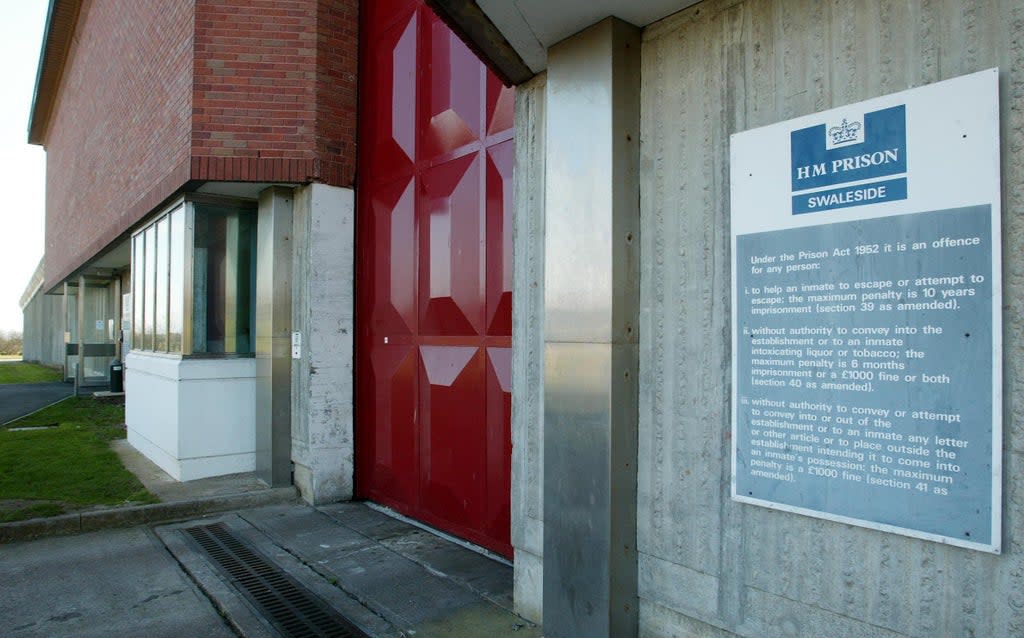Inmate death in cell fire leads coroner to conclude 35 jails ‘unsafe’

An inmate died in a cell fire after two official warnings about safety in prison in the space of four years went unheeded, a coroner has found.
Christian Hinkley, 33, died from smoke inhalation when fire broke out in his cell at HMP Swaleside on July 28, 2019 when prison officers and firefighters could not reach him in time.
An inquest heard smoke could be seen pouring through cracks in the cell door for more than three minutes before the prison’s fire alarm was triggered.
Mr Hinkley had barricaded himself in the cell, hindering efforts of prison guards to put out the blaze, and it was more than half an hour after the alarm had been raised that firefighters were able to reach the prison cell.
Assistant Coroner for Mid Kent and Medway, Scott Matthewson, concluded fire safety systems across 35 prisons in England and Wales are “inadequate and unsafe” and called on government minister Victoria Atkins to take urgent action.
He heard that HMP Swaleside bosses were warned by a fire safety watchdog in 2015 and again in April 2019 – three months before Mr Hinkley’s death – that its systems were “not capable of detecting fires sufficiently early” and in-cell automatic fire detectors had to be installed.
Despite the warnings that lives were at risk, the new detectors are only going to be installed at the Category B jail on the Isle of Sheppey from December next year. It could take seven years to roll-out the measures across the whole prison estate.
Mr Matthewson noted the Ministry of Justice has known since 2007 that prisoners locked in their cells would – without intervention - die within eight minutes of a fire breaking out.
“There is no reasonable prospect of local Fire and Rescue Service firefighters attending the cell with breathing apparatus and firefighting equipment within that timescale,” he said.
“As it stands, and until in-cell fire detectors are installed to prisons, there is a significant risk of death from in-cell fires because the current fire detection systems cannot reliably detect a fire within a timescale that will enable life-saving steps to be taken in time.”
He urged the MoJ to install in-cell detectors urgently for prisoners at risk of suicide, with a history of arson, and prone to barricading themselves in their cells.
An inquest jury found Mr Hinkley, who was two years into a 14-year sentence for domestic abuse, had barricaded himself in his cell when fire broke out.
CCTV footage shows smoke starting to pour into the corridor at 11.35pm, with a fellow inmate and an officer on the wing noticing the emergency before the automatic smoke detectors went off at 11.38pm.
Prison guards, trained to deal with fires, attempted to extinguish the blaze but were hindered by the barricade. The inquest heard firefighters, who had to go through prison security, eventually reached the cell at 12.09am.
The Chief Inspector of the Crown Premises’ Fire Safety Inspectorate (CPFSI) told the inquest Swaleside’s current smoke detection system “is not designed to save life”.
A plan to introduce in-cell detectors across prisons in England and Wales is “in the development stage”, the hearing was told, but is reliant on “sustained funding” to be completed within five to seven years.
“The start date for construction works at HMP Swaleside is scheduled for December 2022,” the MoJ said in written evidence.
A Prison Service spokesperson said: “Our sympathies remain with the family and friends of Mr Hinkley. Our fire detection systems comply with relevant safety standards but we will be installing in-cell detectors at HMP Swaleside as part of a £315 million investment to improve the estate.”
Read More
Comedian Alan Carr’s husband faces prison for drink driving crash with police car
Pitchfork case may mean ‘root and branch’ review of parole system
Alert after prisoner escapes from St George’s Hospital in Tooting

 Yahoo News
Yahoo News 
